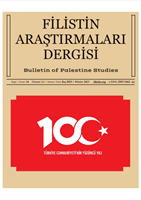Kudüs Nüfus Defterlerine Göre Kent Toplumu ve Mekân (1905-1917): Bab El-Halil Mahallesi Örneği
Urban Society and Public Space According to Population Registers of Jerusalem (1905- 1917): the Case of Bab El-Khalil Neighborhood
Author(s): Yasemin Avci, Ömür Yazici ÖzdemirSubject(s): Cultural history, Social history, Demography and human biology, Rural and urban sociology, Sociology of Culture, Pre-WW I & WW I (1900 -1919)
Published by: Muhammed Mustafa KULU
Keywords: Population Registers; Jerusalem; Urban Society; Public Space; Bab el-Khalil;
Summary/Abstract: Neighborhood affiliation is a well-established component of social identity in the Ottoman cities. The neighborhood, where social relations are formed and developed, has an important function in the production and maintenance of social norms and values. In order to analyze the social identity in cities, the neighborhood structure should be examined; the components and variables of the neighborhood, the internal and external mobility between neighborhoods, partnership and segregation should be evaluated. One of the most important sources to be used for analyzing the neighborhood structure is the Ottoman population registers. The Jerusalem Population Registers housed at the Israel State Archives cover the censuses carried out in 1881 (H. 1299), 1905 (H. 1321) and 1914 (H. 1332), 73 registers out of a total of 463 belong to the urban center of Jerusalem. These registers provide unique data about the demographic and social structure of the neighborhoods, and help to examine the neighborhoods of the city at the “household” level. By comparatively analyzing the censuses carried out on different dates, the changing aspects of the demographic structure and a portrait of rural, regional and international migrations to the city of Jerusalem might be seen. This study examines 8 population registers dated between the years 1905-1917 (H. 1321- 1333) belonging to Bab el-Halil neighborhood, which developed around the Jaffa Gate as the “new center of the city” since the last quarter of the 19th century. The population density and migration portrait of the neighborhood, the ethnic and religious affiliations, marital status, and occupation of the residents is to be evaluated by the graphics based on the data obtained in the population registers.
Journal: FİLİSTİN ARAŞTIRMALARI DERGİSİ
- Issue Year: 2023
- Issue No: 14
- Page Range: 43-74
- Page Count: 32
- Language: Turkish

